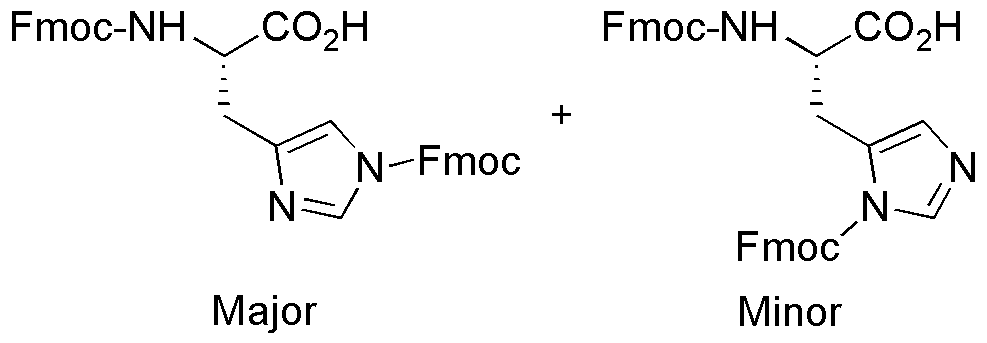Na,im-Bis-Fmoc-L-histidine is widely utilized in research focused on:
- Peptide Synthesis: This compound is a key building block in the synthesis of peptides, particularly in solid-phase peptide synthesis, allowing for the creation of complex biomolecules with high purity and yield.
- Drug Development: It plays a significant role in pharmaceutical research, especially in the design of histidine-containing peptides that can enhance drug solubility and stability, making them more effective in therapeutic applications.
- Bioconjugation: This chemical is used in bioconjugation processes to attach drugs or imaging agents to proteins, enhancing their functionality and targeting capabilities in medical diagnostics and treatments.
- Research in Enzyme Activity: It is utilized in studies investigating enzyme mechanisms and interactions, particularly those involving histidine residues, providing insights into metabolic pathways and potential drug targets.
- Protein Engineering: The compound is valuable in protein engineering, where it aids in the design of novel proteins with specific properties, contributing to advancements in biotechnology and synthetic biology.
General Information
Properties
Safety and Regulations
Applications
Na,im-Bis-Fmoc-L-histidine is widely utilized in research focused on:
- Peptide Synthesis: This compound is a key building block in the synthesis of peptides, particularly in solid-phase peptide synthesis, allowing for the creation of complex biomolecules with high purity and yield.
- Drug Development: It plays a significant role in pharmaceutical research, especially in the design of histidine-containing peptides that can enhance drug solubility and stability, making them more effective in therapeutic applications.
- Bioconjugation: This chemical is used in bioconjugation processes to attach drugs or imaging agents to proteins, enhancing their functionality and targeting capabilities in medical diagnostics and treatments.
- Research in Enzyme Activity: It is utilized in studies investigating enzyme mechanisms and interactions, particularly those involving histidine residues, providing insights into metabolic pathways and potential drug targets.
- Protein Engineering: The compound is valuable in protein engineering, where it aids in the design of novel proteins with specific properties, contributing to advancements in biotechnology and synthetic biology.
Documents
Safety Data Sheets (SDS)
The SDS provides comprehensive safety information on handling, storage, and disposal of the product.
Product Specification (PS)
The PS provides a comprehensive breakdown of the product’s properties, including chemical composition, physical state, purity, and storage requirements. It also details acceptable quality ranges and the product's intended applications.
Certificates of Analysis (COA)
Search for Certificates of Analysis (COA) by entering the products Lot Number. Lot and Batch Numbers can be found on a product’s label following the words ‘Lot’ or ‘Batch’.
*Catalog Number
*Lot Number
Certificates Of Origin (COO)
This COO confirms the country where the product was manufactured, and also details the materials and components used in it and whether it is derived from natural, synthetic, or other specific sources. This certificate may be required for customs, trade, and regulatory compliance.
*Catalog Number
*Lot Number
Safety Data Sheets (SDS)
The SDS provides comprehensive safety information on handling, storage, and disposal of the product.
DownloadProduct Specification (PS)
The PS provides a comprehensive breakdown of the product’s properties, including chemical composition, physical state, purity, and storage requirements. It also details acceptable quality ranges and the product's intended applications.
DownloadCertificates of Analysis (COA)
Search for Certificates of Analysis (COA) by entering the products Lot Number. Lot and Batch Numbers can be found on a product’s label following the words ‘Lot’ or ‘Batch’.
*Catalog Number
*Lot Number
Certificates Of Origin (COO)
This COO confirms the country where the product was manufactured, and also details the materials and components used in it and whether it is derived from natural, synthetic, or other specific sources. This certificate may be required for customs, trade, and regulatory compliance.

